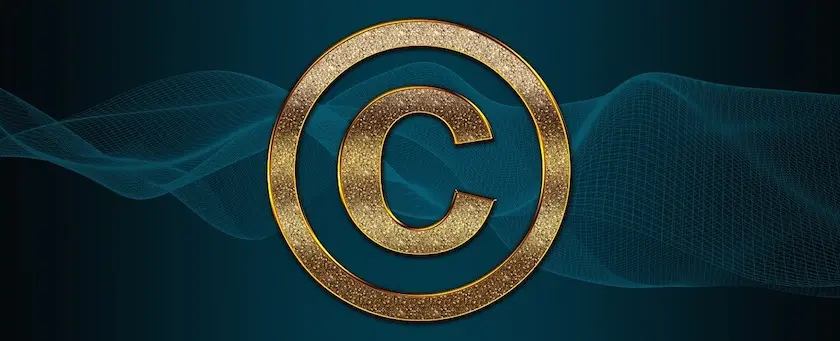What is Copyright?
Copyright explained and do you have to use the copyright symbol to be able to claim your right?

Copyright is a legal concept that grants individuals or entities the exclusive right to reproduce, distribute, and display their original creative works. It is part of intellectual property law and protects various forms of expression, such as literary, artistic, and musical works, from unauthorized use by others. Copyright is indicated by the internationally well-known and frequently used copyright symbol, ©. The correct accompanying expression is then "this work is protected by copyright." But are the copyright symbol and the tekst required to protect your creative work?
What is copyright? Copying without permission is prohibited and it can lead to prosecution
First, let's talk about copyright itself. If someone has written a particular text, others are not allowed to simply copy and use it due to copyright law. This is even considered a criminal offense, regulated by copyright law. To enforce copyright, it is not necessary to include the copyright symbol! Additionally, there is no need to register the texts or take any other form of formal registration. If someone uses your text or part of it, that person is simply committing a crime. This applies not only to texts but also to photos, images, and, for example, the text of this web page. It cannot be copied and placed on another site without proper authorization. However, there are certain conditions. To obtain copyright, the work must meet the following conditions:
- The work must have a personal character; it must be original. In other, more formal words: to fall under copyright, the work must be the author's own intellectual creation and an expression of their personality (this is called the personal touch). However, it is allowed to retell an existing story in your own words. Blatantly copying is prohibited, but rewriting in your own words is allowed.
- The aforementioned personal and original work must also be perceptible through reading, hearing, or seeing. It is not enough for it to exist only in your head. It must be tangible so that others can become aware of it.
The good news: the copyright symbol does not need to be present, and copyright arises automatically
Your work has to be concrete and original. Copyright is thus automatically created by producing an original (own) work and recording it for others to perceive. Unlike applying for a patent, copyright does not need to be registered anywhere. If the work is of significant value, it may be important at some point to prove that you are the creator of it. In this case, adding a date stamp to the work can be helpful, and there are various options for that.
Registering Copyright?
The only requirement for claiming copyright is that the work must be original and creative. On the other hand, it can be challenging to prove that you are the thinker and creator of the respective work.
The copyright law states that the person mentioned with the work is presumed to be its creator. In most cases, this is true. However, if two parties claim to be the originator of a work, additional evidence must be provided, such as a date stamp on the work. In this case, it is plausible that the one with the oldest version is the creator. Therefore, it is always wise to include not only your name but also the date on your creations.
Registering Copyright by Agencies and Commercial Entities?
We mentioned that the person with the oldest date on the work is presumed to be the creator, but it's possible that a malicious individual intentionally provides a copy of your work with a (much) older date than when you created it. To strengthen your position, you can have the work stamped with a date. There are various agencies that can do this for you. Keep in mind that this method of dating does not determine the actual creator of the work. Someone else could also use this method to date a copy of your work. This only proves that the document existed on the specified date, nothing more and nothing less. Some (especially commercial) entities suggest that they register your copyright in this way, but that is not the case. That doesn't mean you can't use the services offered, but be aware of this limitation.
It is possible to open an i-DEPOT at the Benelux Office for Intellectual Property (BOIP). This is a service to provide documents with an official date registration by an official institution. They offer two options, online submission and digital dating, and there is also the option to handle everything by mail. Again, this only serves as proof that the document existed on the specified date. The i-DEPOT is recognized as valid evidence across the European Union and can also be employed in non-European countries. Courts outside of Europe independently determine whether to acknowledge the i-DEPOT as evidence. Given that BOIP serves as the official entity in the Benelux for trademark and model registrations, and the i-DEPOT is explicitly defined in the BCIP, it is probable that courts outside of Europe will accept the i-DEPOT as a credible form of evidence.
Date Registration by a Notary
It is also possible to have a document dated by a notary. The notary has various options for this, including the option to create an authentic deed describing the content of the work. It is clear that this process is cumbersome and relatively expensive, but the law stipulates that what the notary states is deemed to be true.... Consult with your notary for the available options.
Preserving Draft Versions
All things considered, registering copyright is not possible, and theoretically, someone could officially date a copy of your work before you do. Indeed, it is unfair, but it happens, and in such a case, having preserved drafts and versions can be helpful. After all, only the original creator and maker of the work will possess these. Unless....
Registering Copyright with an Envelope?
First, something else. Sometimes it is suggested to send a work to yourself. The postmark on the envelope would then serve as proof that the work existed on that date. However, this is not convincing evidence because an envelope does not need to be sealed when sent. The postmark only proves that the envelope was sent on that date, not that the work was actually inside.
The conclusion is that such date registration can help demonstrate that you are the creator of the brilliant text, photo, or image, but the proof is not foolproof.
How Long Can You Use Copyright?
As mentioned, copyright provides the creator of a work with the right to use it. The creator can also grant permission, with or without payment, for others to use the work. This often happens in practice, especially with valuable works, and is usually documented in a contract. When the creator of the work passes away, the copyright automatically transfers to their heirs for a period of up to 70 years after the creator's death. This means that works by authors who have long since passed away may be freely available on the internet, as they are no longer under copyright.
According to Article 1 of the copyright law, the creator of a work has the exclusive right to make it public and reproduce it, and the creator can resist infringement of that right. In other words, if someone copies your work, it constitutes an infringement, and you can take legal action. The vagueness of the term "work" in copyright law allows for considerable discussion, and to support you in such matters, there are lawyers who specialize in copyright, known as copyright attorneys.
